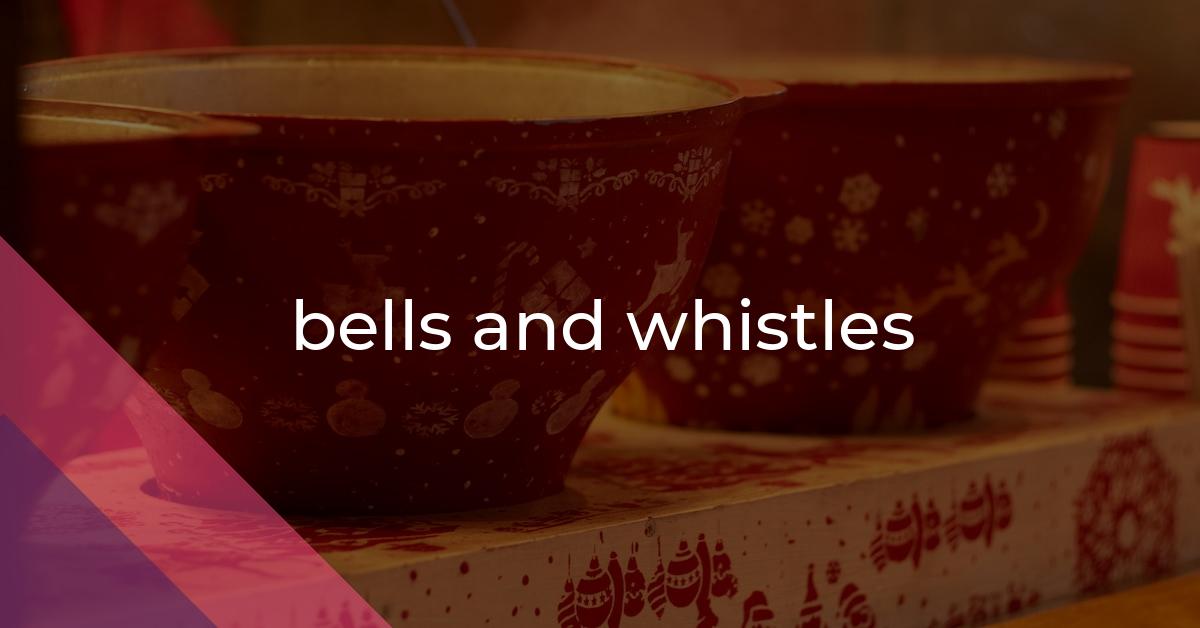bells and whistles: Idiom Meaning and Origin
What does ‘bells and whistles’ mean?
The idiom *bells and whistles* refers to additional attractive or impressive features that are added to something in order to make it more appealing or exciting, but may not necessarily be essential or functional.

Idiom Explorer
The idiom "put on frills" means to add unnecessary or excessive decorative details or embellishments to something, typically to make it more attractive or impressive.
The idiom "everything but the kitchen sink" means including almost everything, often used to express an excessive or overwhelming amount of things or information.
The idiom "element of surprise" refers to the unexpected or unforeseen component or factor that creates a stunning or shocking outcome in a situation.
The idiom "easy on the eye" means visually attractive or pleasing to look at.
The idiom "curb appeal" refers to how attractive or enticing something appears at first glance, especially a building or property when viewed from the street.
The idiom "chime in" means to join a conversation or discussion, especially when adding an opinion or comment. It implies jumping into a conversation already in progress.
The idiom "catch the eye" means to attract attention or be visually striking.
The idiom "busy work" refers to tasks or activities that appear to be important or productive, but in reality, they are trivial and do not contribute to any meaningful or significant outcome.
The idiom "bright lights" refers to the glare and excitement found in big cities or show business. It can also symbolize success, fame, and the lure of a glamorous lifestyle.
The idiom "bragging rights" refers to the satisfaction or privilege gained from being able to boast or brag about a particular achievement, status, or possession. It implies a sense of superiority or pride, often used in a playful or competitive context.
Symphony Revealed
The idiom "bells and whistles" is a commonly used phrase in English. It refers to extra features or embellishments added to something, often a product or technology, to make it more attractive. This expression conveys the idea of flashy elements that may not actually enhance the core functionality or value of the object.
The origin of the idiom can be traced back to the early 20th century when bells and whistles were used in entertainment and amusements. These attention-grabbing elements were often found in merry-go-rounds, carnival games, and other attractions. Eventually, people started using the phrase "bells and whistles" metaphorically to describe non-essential additions that were intended to impress.
The idiom gained popularity in the 1960s and 1970s when it became associated with technology, particularly computer programming and software development. As computer systems and software became more advanced, developers began adding extra features. However, these additional elements were often seen as unnecessary or distracting, leading to the adoption of the idiom "bells and whistles" to criticize such additions.
With time, the phrase "bells and whistles" became widely used in everyday conversations, business settings, and various forms of media. It is commonly used to critique objects, services, or technologies that have excessive or unnecessary features that do not enhance their overall value. The idiom serves as a reminder to focus on the core aspects and essential functionality of things rather than getting distracted by flashy or superfluous elements.
The idiom "bells and whistles" can be related to several other idioms. One such idiom is "put on frills." Both these idioms refer to adding unnecessary embellishments. While "bells and whistles" specifically relates to technology and products, "put on frills" has a broader application and can refer to any situation where non-essential elements are added for show.
Another related phrase is "at that." "At that" is often used to emphasize a particular point or feature. Similarly, "bells and whistles" can be used to emphasize and draw attention to added features or embellishments.
The idiom "and whatnot" is another related expression. It is used to refer to additional unspecified things or elements. In the context of "bells and whistles," "and whatnot" can be used to suggest the presence of other unnecessary or excessive features that are not explicitly mentioned.
The idiom "bright lights" is also connected to "bells and whistles." "Bright lights" refers to flashy or showy elements that may attract attention but do not necessarily contribute to the essential aspect or value of something. This aligns with the idea behind "bells and whistles" in emphasizing the importance of focusing on the core functionality rather than being swayed by superficial elements.
Lastly, the expression "all sizzle and no steak" shares a similar concept with "bells and whistles." "All sizzle and no steak" refers to something that appears impressive or exciting but lacks substance or real value. This directly correlates with the notion behind "bells and whistles" in highlighting the importance of not being deceived by flashy or superficial aspects that do not enhance the essential purpose of an object or concept.
The idiom "bells and whistles" is a metaphorical expression that originated from the use of actual bells and whistles in entertainment and amusement. Today, it is widely used to describe non-essential features or embellishments added to something to make it more appealing, especially in the context of technology. The idiom serves as a reminder to focus on the fundamental elements rather than being swayed by extravagant or unnecessary additions. While the idiom has a clear meaning, its usage and interpretation may evolve over time, allowing for further linguistic exploration and analysis.
Example usage
Examples of how the idiom *bells and whistles* can be used in a sentence:
- The new smartphone has all the bells and whistles, including a high-resolution display and a powerful processor.
- Don't just focus on adding bells and whistles to your presentation; make sure the content is strong and engaging.
- I prefer a simple and functional design for my car, without all the unnecessary bells and whistles.
More "Expressions" idioms



